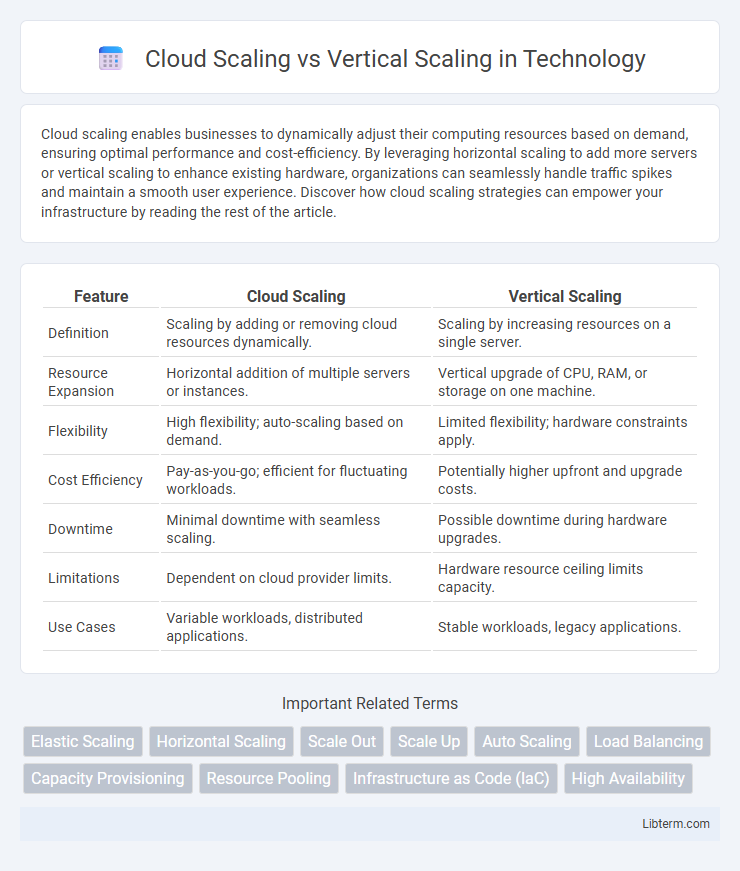Cloud scaling enables businesses to dynamically adjust their computing resources based on demand, ensuring optimal performance and cost-efficiency. By leveraging horizontal scaling to add more servers or vertical scaling to enhance existing hardware, organizations can seamlessly handle traffic spikes and maintain a smooth user experience. Discover how cloud scaling strategies can empower your infrastructure by reading the rest of the article.
Table of Comparison
| Feature | Cloud Scaling | Vertical Scaling |
|---|---|---|
| Definition | Scaling by adding or removing cloud resources dynamically. | Scaling by increasing resources on a single server. |
| Resource Expansion | Horizontal addition of multiple servers or instances. | Vertical upgrade of CPU, RAM, or storage on one machine. |
| Flexibility | High flexibility; auto-scaling based on demand. | Limited flexibility; hardware constraints apply. |
| Cost Efficiency | Pay-as-you-go; efficient for fluctuating workloads. | Potentially higher upfront and upgrade costs. |
| Downtime | Minimal downtime with seamless scaling. | Possible downtime during hardware upgrades. |
| Limitations | Dependent on cloud provider limits. | Hardware resource ceiling limits capacity. |
| Use Cases | Variable workloads, distributed applications. | Stable workloads, legacy applications. |
Introduction to Cloud Scaling and Vertical Scaling
Cloud scaling involves distributing resources across multiple servers or instances to efficiently manage increased workloads, enhancing application performance and availability. Vertical scaling, also known as scaling up, increases a single server's capacity by adding more CPU, RAM, or storage to handle larger tasks. Both scaling methods address demand growth in cloud computing, with cloud scaling emphasizing horizontal expansion and vertical scaling focusing on upgrading existing infrastructure.
Defining Cloud Scaling: Concepts and Types
Cloud scaling refers to the dynamic allocation of computing resources to meet varying workloads, primarily categorized into vertical scaling (scaling up) and horizontal scaling (scaling out). Vertical scaling involves increasing the capacity of a single server or virtual machine by adding more CPU, RAM, or storage, enhancing performance without changing the architecture. Horizontal scaling entails adding more servers or instances to distribute the load, improving fault tolerance and enabling seamless handling of traffic spikes in cloud environments.
What is Vertical Scaling? Key Principles
Vertical scaling, also known as scaling up, involves increasing the capacity of a single server or resource by adding more CPU, RAM, or storage to enhance performance. Key principles include maximizing existing hardware capabilities to support higher workloads without distributing tasks across multiple systems. This method offers simpler management and reduced latency but faces limitations in hardware capacity and single points of failure.
Horizontal vs Vertical Scaling: Core Differences
Horizontal scaling involves adding more servers or instances to distribute workloads, enhancing performance and fault tolerance by expanding infrastructure capacity. Vertical scaling increases the resources of a single server, such as CPU, RAM, or storage, to improve performance without altering the system architecture. Core differences include flexibility, with horizontal scaling offering better redundancy and scalability for cloud environments, while vertical scaling typically provides simpler implementation but is limited by hardware constraints.
Advantages of Cloud (Horizontal) Scaling
Cloud scaling, or horizontal scaling, offers the significant advantage of distributing workloads across multiple servers, enhancing fault tolerance and system reliability. This method enables seamless resource expansion to handle increasing traffic without downtime, making it ideal for dynamic, cloud-based environments. Horizontal scaling also allows cost-effective, incremental infrastructure growth as demand fluctuates, optimizing operational expenditures compared to vertical scaling's hardware limitations.
Benefits and Limitations of Vertical Scaling
Vertical scaling enhances server performance by increasing CPU, RAM, or storage capacity within a single machine, offering simplicity and minimal downtime during upgrades. It benefits applications requiring high processing power without complex architecture changes but is limited by hardware constraints and potential single points of failure. Vertical scaling lacks the elasticity and fault tolerance of cloud scaling, making it less suitable for highly variable or large-scale workloads.
Cost Implications: Cloud Scaling vs Vertical Scaling
Cloud scaling, which involves dynamically adding or removing resources based on demand, often results in cost efficiency by preventing over-provisioning and allowing pay-as-you-go pricing models. Vertical scaling, or upgrading existing hardware capacity, can incur substantial upfront investments and may lead to higher long-term costs due to limitations in scalability and potential downtime during upgrades. Cloud scaling offers more flexible cost management aligned with workload fluctuations compared to the fixed expenses associated with vertical scaling.
Performance and Scalability Considerations
Cloud scaling offers dynamic resource allocation that enhances performance by automatically adjusting to workload demands, ensuring seamless scalability across multiple servers. Vertical scaling improves performance by increasing the capacity of an existing server, but it faces hardware limitations that restrict long-term scalability. Cloud environments prioritize horizontal scaling to maintain high availability and fault tolerance, while vertical scaling is best suited for applications with predictable workloads and limited scalability needs.
Use Cases: When to Choose Each Scaling Method
Cloud scaling offers horizontal scaling, ideal for applications requiring high availability and load balancing across multiple servers, such as e-commerce platforms during peak traffic. Vertical scaling suits databases or legacy applications needing enhanced performance by upgrading existing hardware resources like CPU or RAM without modification to the application architecture. Choosing between scaling methods depends on factors like application design, cost constraints, and the need for fault tolerance and rapid resource adjustment.
Future Trends in Infrastructure Scaling
Future trends in infrastructure scaling emphasize hybrid models combining cloud scaling's elasticity with vertical scaling's hardware upgrades to optimize performance and cost-efficiency. Advances in AI-driven automation and predictive analytics enable dynamic resource allocation, reducing downtime and enhancing scalability in response to real-time demand. Edge computing integration further shapes scalability strategies by distributing workloads closer to data sources, minimizing latency and supporting IoT and 5G growth.
Cloud Scaling Infographic

 libterm.com
libterm.com